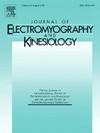Does hemiparetic dorsiflexion in swing phase depend on spasticity?
IF 2.3
4区 医学
Q3 NEUROSCIENCES
引用次数: 0
Abstract
Objective
This study quantified dorsiflexor and plantar flexor (PF) spasticity, and agonist and antagonist recruitment (cocontractions) during the swing phase of gait in individuals with hemiparesis with and without prior tibial neurotomy, investigating the role of spastic cocontraction versus spasticity in limiting dorsiflexion (DF).
Methods
Eleven hemiparetic subjects and 11 controls walking at comfortable and slow velocities underwent kinematic and electromyographic (EMG) analysis of PF and DF muscles. Five of the hemiparetic subjects had undergone tibial nerve neurotomy, which eliminates PF spasticity. Key metrics included ankle dorsiflexion, tibialis anterior recruitment, and coefficients of antagonist activation of gastrocnemius medialis and soleus during swing. Spasticity was assessed using the Tardieu scale.
Results
Controls walking at slow speed showed similar velocity as hemiparetic subjects. Hemiparetic subjects showed reduced ankle dorsiflexion despite higher tibialis anterior recruitment, increased plantar flexor cocontraction before any dorsiflexion, even in neurotomy patients without spasticity.
Conclusions
Increased PF cocontraction persists even in the absence of spasticity, limiting dorsiflexion during swing. Spastic cocontraction, not spasticity, is a primary factor impairing active DF.
Significance
These findings emphasize that targeting spastic cocontraction of plantar flexors may be crucial for improving dorsiflexion and gait rehabilitation in hemiparetic patients, instead of addressing spasticity.
摇摆期偏瘫背屈是否与痉挛有关?
目的:本研究量化偏瘫患者在步态摇摆期背屈肌和足底屈肌(PF)的痉挛,以及激动剂和拮抗剂的招募(收缩),研究痉挛性收缩与痉挛性收缩在限制背屈(DF)中的作用。方法对6例偏瘫患者和11例正常人进行慢速舒适步行的运动和肌电图(EMG)分析。5名偏瘫患者接受了胫骨神经切开术,消除了PF痉挛。关键指标包括踝关节背屈,胫骨前肌恢复,以及在摆动过程中腓肠肌内侧肌和比目鱼肌的拮抗剂激活系数。采用Tardieu量表评估痉挛程度。结果对照组慢速行走速度与偏瘫组相近。偏瘫患者表现出踝关节背屈减少,尽管胫骨前肌收缩增加,在任何背屈之前足底屈肌收缩增加,即使在没有痉挛的神经切开术患者中也是如此。结论:即使在没有痉挛的情况下,PF收缩的增加仍然存在,限制了摆动时的背屈。痉挛性收缩,而不是痉挛,是损害活性DF的主要因素。这些发现强调,针对足底屈肌的痉挛性收缩可能对改善偏瘫患者的背屈和步态康复至关重要,而不是解决痉挛问题。
本文章由计算机程序翻译,如有差异,请以英文原文为准。
求助全文
约1分钟内获得全文
求助全文
来源期刊
CiteScore
4.70
自引率
8.00%
发文量
70
审稿时长
74 days
期刊介绍:
Journal of Electromyography & Kinesiology is the primary source for outstanding original articles on the study of human movement from muscle contraction via its motor units and sensory system to integrated motion through mechanical and electrical detection techniques.
As the official publication of the International Society of Electrophysiology and Kinesiology, the journal is dedicated to publishing the best work in all areas of electromyography and kinesiology, including: control of movement, muscle fatigue, muscle and nerve properties, joint biomechanics and electrical stimulation. Applications in rehabilitation, sports & exercise, motion analysis, ergonomics, alternative & complimentary medicine, measures of human performance and technical articles on electromyographic signal processing are welcome.

 求助内容:
求助内容: 应助结果提醒方式:
应助结果提醒方式:


